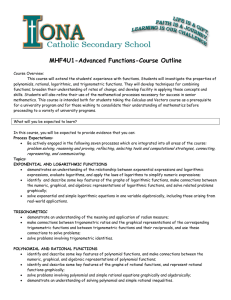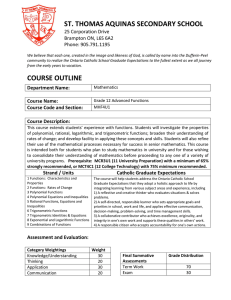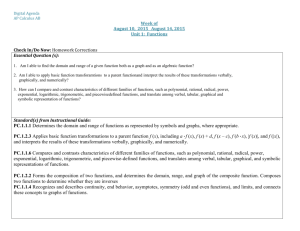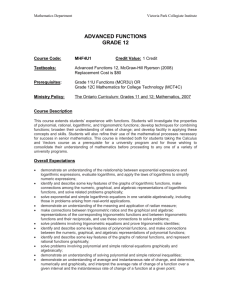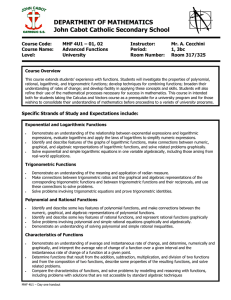Notre Dame Catholic Secondary School Course Code: MHF4U1-03
advertisement
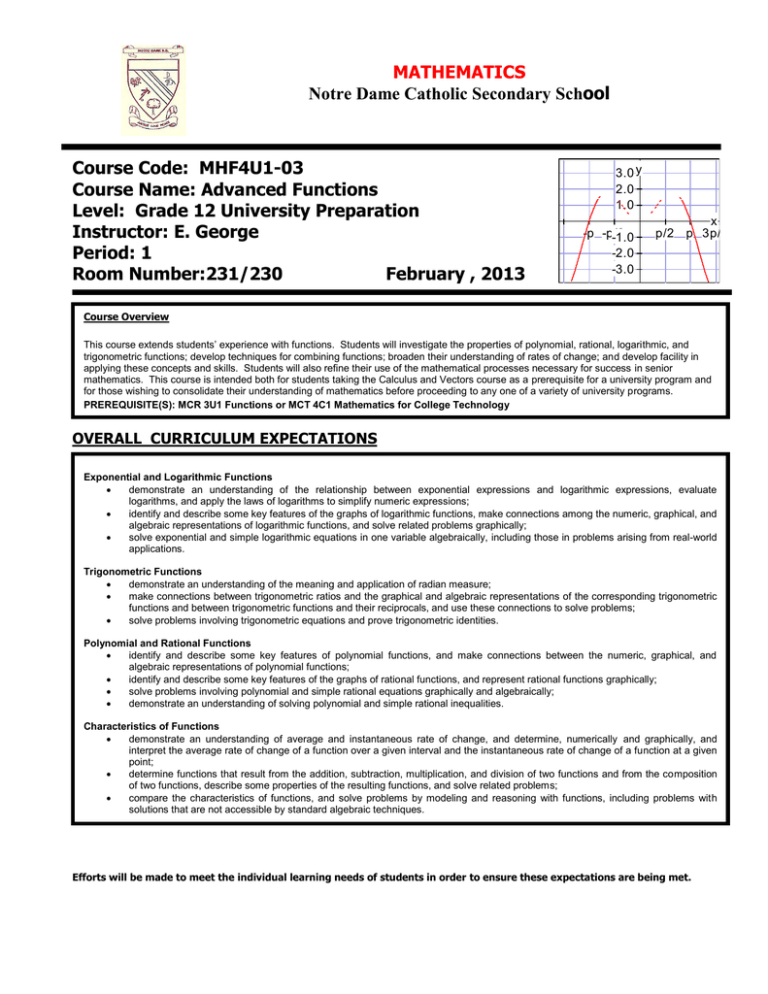
MATHEMATICS Notre Dame Catholic Secondary School Course Code: MHF4U1-03 Course Name: Advanced Functions Level: Grade 12 University Preparation Instructor: E. George Period: 1 Room Number:231/230 February , 2013 3.0 y 2.0 1.0 -p -p/2 -1.0 -2.0 -3.0 x p/2 p 3p/2 Course Overview This course extends students’ experience with functions. Students will investigate the properties of polynomial, rational, logarithmic, and trigonometric functions; develop techniques for combining functions; broaden their understanding of rates of change; and develop facility in applying these concepts and skills. Students will also refine their use of the mathematical processes necessary for success in senior mathematics. This course is intended both for students taking the Calculus and Vectors course as a prerequisite for a university program and for those wishing to consolidate their understanding of mathematics before proceeding to any one of a variety of university programs. PREREQUISITE(S): MCR 3U1 Functions or MCT 4C1 Mathematics for College Technology OVERALL CURRICULUM EXPECTATIONS Exponential and Logarithmic Functions demonstrate an understanding of the relationship between exponential expressions and logarithmic expressions, evaluate logarithms, and apply the laws of logarithms to simplify numeric expressions; identify and describe some key features of the graphs of logarithmic functions, make connections among the numeric, graphical, and algebraic representations of logarithmic functions, and solve related problems graphically; solve exponential and simple logarithmic equations in one variable algebraically, including those in problems arising from real-world applications. Trigonometric Functions demonstrate an understanding of the meaning and application of radian measure; make connections between trigonometric ratios and the graphical and algebraic representations of the corresponding trigonometric functions and between trigonometric functions and their reciprocals, and use these connections to solve problems; solve problems involving trigonometric equations and prove trigonometric identities. Polynomial and Rational Functions identify and describe some key features of polynomial functions, and make connections between the numeric, graphical, and algebraic representations of polynomial functions; identify and describe some key features of the graphs of rational functions, and represent rational functions graphically; solve problems involving polynomial and simple rational equations graphically and algebraically; demonstrate an understanding of solving polynomial and simple rational inequalities. Characteristics of Functions demonstrate an understanding of average and instantaneous rate of change, and determine, numerically and graphically, and interpret the average rate of change of a function over a given interval and the instantaneous rate of change of a function at a given point; determine functions that result from the addition, subtraction, multiplication, and division of two functions and from the composition of two functions, describe some properties of the resulting functions, and solve related problems; compare the characteristics of functions, and solve problems by modeling and reasoning with functions, including problems with solutions that are not accessible by standard algebraic techniques. Efforts will be made to meet the individual learning needs of students in order to ensure these expectations are being met. Resources: Chapter 1: Chapter 1: CC c Chapter 2: Chapter 3: Chapter 4: Chapter 5: Chapter 6: Chapter 7: Chapter 8: Chapter 9: Functions Characteristics and properties. Functions characteristics and properties Functions: Understanding rates of change Polynomial Functions Polynomial equations and inequalities Rational Functions, equations and inequalities. Trigonometric Functions Trigonometric Identities and equations. Exponential and Logarithmic Functions Combinations of Functions The course will use a variety of resources. The textbook, Advanced Functions (Nelson) will be distributed to students during the first week of the course. The text and all other resources assigned to students are the responsibility of the student. Any damage incurred will result in payment for replacement. Replacement cost for the textbook is $100.00. Evaluation Structure:: Knowledge/Understanding Thinking/Inquiry Communication Application 30 % 20% 20 % 30% The above is reflected both in the term work (worth 70% of the final mark) and f the Final Exam (30%). Evaluation Policy Students will be assessed & evaluated according to the work produced & skills displayed. Methods of providing feedback will include assessing work in process & evaluating completed assignments, tests, co-operative learning activities, simulations and presentations. Peer & self-evaluations will also be utilized. Student marks will be determined by evaluating process & product according to 4 categories & 4 levels. Please see the chart below for specific skills and key words used to determine student competency in the different categories. Category Level Knowledge/Understanding Knowledge of facts & terms Understanding of concepts & relationships Thinking Critical thinking skills Creative thinking skills Inquiry Skills Communication Communication of ideas and information Use of symbols & visuals Oral & written communication Level 1: 50-59% Level 2: 60-69% Level 3: 70-79% Level 4: 80-100% -Limited display of knowledge, skills and ability to apply concepts -Some success in displaying knowledge, skills and application of concepts -Considerable display of knowledge skills and ability to apply concepts -Thorough understanding of concepts and ability to communicate, think creatively and apply concepts Application Applications in familiar contexts Transfer of concepts to new contexts Making logical conclusions and predictions Use of technology Making connections Feedback will also be provided for student learning skills. Skills like working independently, team work, organization, work habits and homework, and initiative are assessed independently student achievement and will be conducted through the use of a rubric indicating specific criteria to be achieved to receive each of the following letter grades: E –Excellent G – Good S – Satisfactory N - Needs Improvement Other Evaluation Issues LATE ASSIGNMENTS. Assignments submitted after the Primary Due Date established by the teacher will be accepted with a penalty of 5% off for the first day late and 2% for subsequent days to a maximum of 10%. This four day Penalty Zone is the maximum time allowed for submissions. The fourth day after the assignment is due is considered the Closure Date upon which no further assignments will be accepted. If the teacher returns the marked assignments within the four day penalty zone, the date of return is considered the closure date. Repeated lateness in submissions indicates poor organization skills and will result in parental contact and will be reflected in the learning skills section of the report card. INCOMPLETE ASSSIGNMENTS Assignments will be graded according to the extent with which they meet the criteria established in the rubric or evaluation structure. MISSED TESTS Tests missed with a legitimate reason will be written within a few days of the student returning from the absence. Student eligibility to write the test and the date of writing will be at the discretion of the teacher in consultation with the department head. Plagiarism in any form reflects academic dishonesty and will result in a mark of zero for the assignment in question

